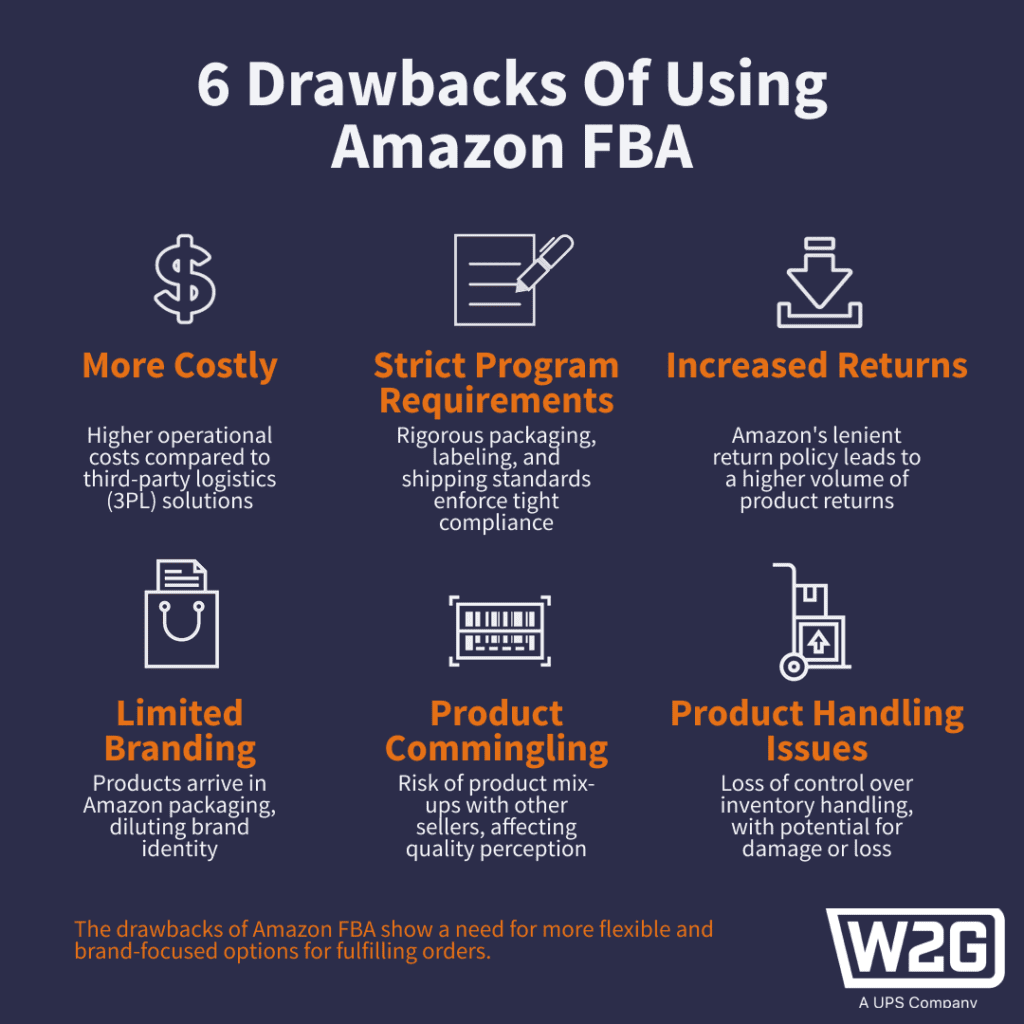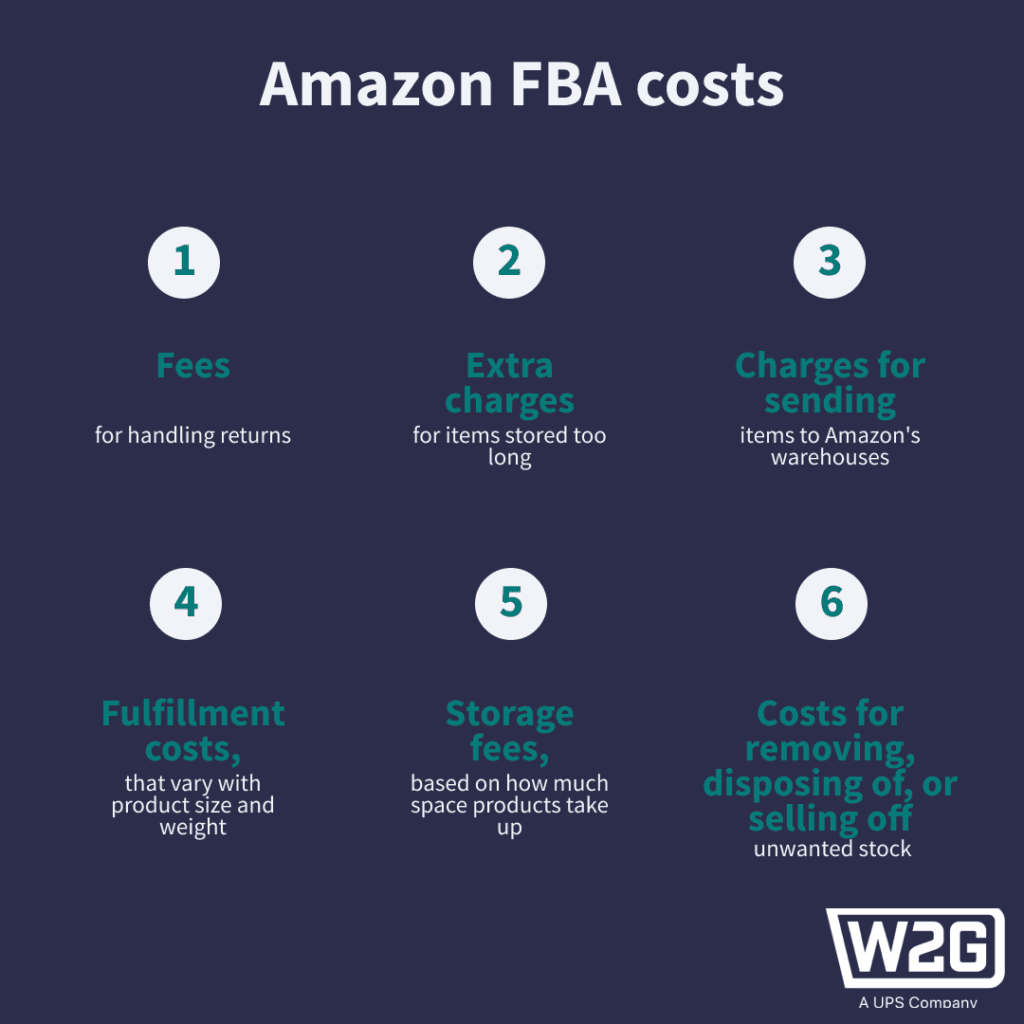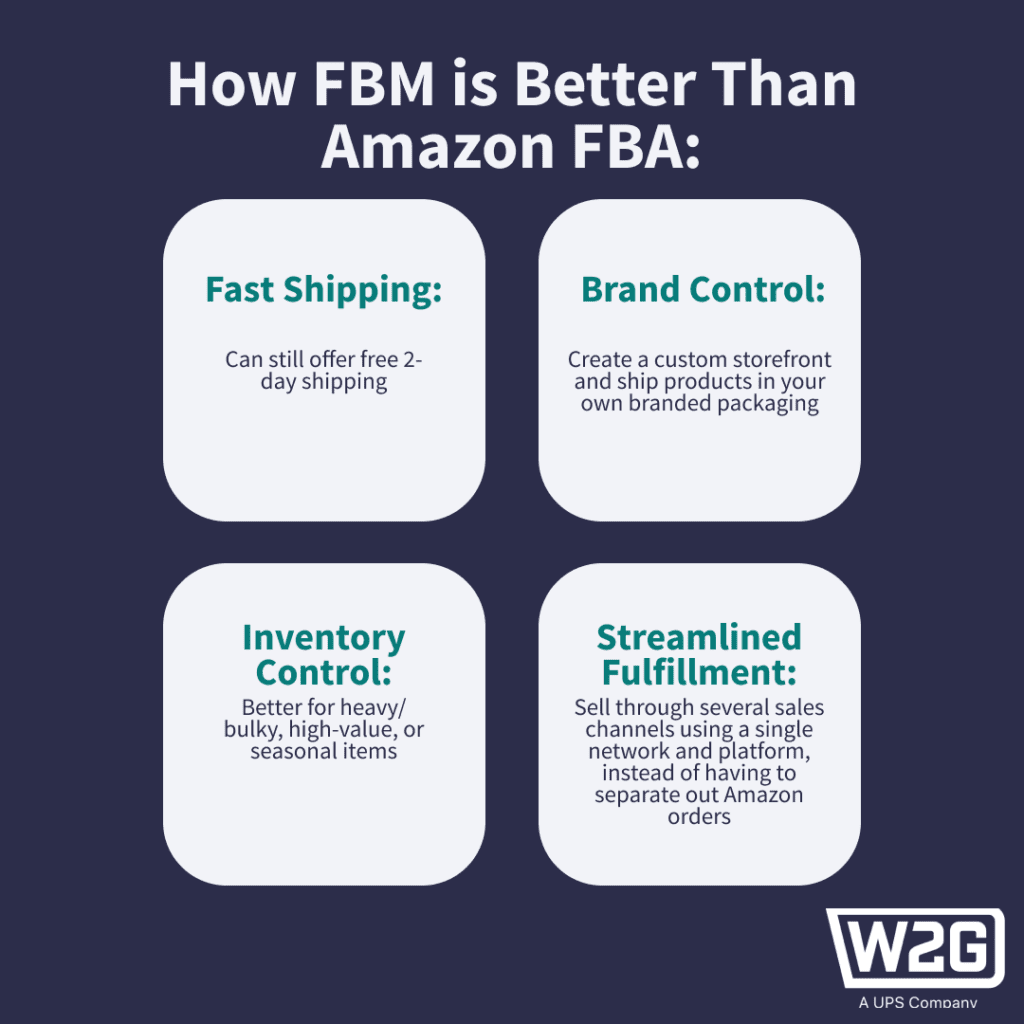Explore alternatives to Amazon FBA with our guide. Learn the benefits of FBM, how to set it up, and strategies to grow your Amazon sales without FBA costs.

Explore alternatives to Amazon FBA with our guide. Learn the benefits of FBM, how to set it up, and strategies to grow your Amazon sales without FBA costs.
Fulfillment by Amazon (FBA Amazon) has become synonymous with speed and efficiency, but sellers may be sacrificing flexibility and scalability for the coveted Amazon Prime badge.
Discover the blueprint for customer loyalty — Check out our detailed guide on improving your fulfillment process to gain loyal customers.
Ever-evolving fulfillment fees, surcharges, and inventory limits based on changing requirements give sellers little flexibility, and a lack of visibility hinders growth.
Third-party sellers now account for 60% of sales on Amazon. Many of those sellers rely on FBA for fulfillment. But with Amazon reopening SFP enrollment in 2023, many looked for ways to sell without FBA on Amazon.

While the benefit of FBA Amazon is guaranteed Prime status, a 2022 consumer survey revealed that more than 80% of Prime shoppers are just as likely or more likely to purchase a non-Prime product as a Prime product – as long there’s the promise of 2-day delivery.
This guide contains everything you need to know about offering 2-day shipping on Amazon and across all your sales channels without relying on Amazon FBA.
Learn how fulfilling Amazon orders through an outsourced fulfillment partner helps you build your brand through customized packaging, more access to customer data, and the ability to sell across multiple sales channels through a single fulfillment network.
Costs Associated with Using Amazon FBA
How can I sell on Amazon without FBA?
In what ways is Fulfillment by Merchants (FBM) better than Fulfillment by Amazon (FBA)?
How to Grow on Amazon without FBA
Amazon offers three fulfillment options for third-party sellers: Fulfillment by Amazon (FBA Amazon), Fulfillment by Merchant (FBM), and Seller-Fulfilled Prime (SFP).
Powered by Amazon’s internal fulfillment and logistics network, FBA’s primary purpose is to provide 1-to 2-day delivery (and, increasingly, same-day delivery) to Amazon Prime members. FBA allows third-party sellers to store products in Amazon’s warehouses, and Amazon handles fulfillment, shipping, and customer interaction on behalf of third-party sellers. Amazon takes a percentage of sales and delivers products in Amazon Prime packaging.
Merchants are responsible for preparing and shipping inventory to Amazon distribution centers, and Amazon disperses the inventory throughout its network. Most importantly, when you sell on Amazon FBA, enrollment guarantees Prime status, placing products at the top of shoppers’ Amazon search results and conveying the 2-day delivery promise today’s customers expect.
The convenience and efficiency of FBA Amazon makes it possible for nearly anyone to sell on Amazon, but serious sellers looking to scale their brand will soon begin to see the limitations of FBA on Amazon.
When considering Amazon FBA for your eCommerce needs, it’s important to be aware of its limitations. Here are some drawbacks you might encounter when using Amazon FBA instead of fulfilling orders yourself or using a third-party logistics (3PL) provider:
Once your inventory is in an Amazon facility, they won’t offer any specialized treatment. This is a big pain point for beverage companies, for example, that want to offer a variety pack. For example, you’d need to break up existing flavors and repackage them together to run a deal, which an Amazon FBA won’t do. This drawback limits your ability to run promotions and special offers, like ‘BOGO’ deals.
Depending on your product size and category, opting for FBA Amazon might lead to higher expenses than collaborating with a 3PL provider, which could offer more cost-effective solutions tailored to your business needs.
Amazon imposes stringent packaging, labeling, and shipping requirements. Keeping compliant can be time-consuming and demands meticulous attention to detail.
The customer-friendly return policy of Amazon FBA creates a higher volume of returns, impacting your bottom line and inventory management.
Your products shipped to customers via Amazon FBA arrive in Amazon-branded packaging, which might lead customers to associate your products more with Amazon than with your brand.
If you’re selling the same product as another third-party merchant, Amazon may pool together similar products. This means your customers may receive lower-quality items from other sellers instead of the product you sent to FBA Amazon, potentially lowering customer satisfaction.
Product handling is outside your control once your inventory is in Amazon’s hands. The risk of lost or damaged items during the fulfillment process is worth considering.
Understanding Amazon FBA’s limitations helps you seek better solutions, improving your brand control and cost-effectiveness. Next, we’ll explore how to sell on Amazon more efficiently without FBA.
Understanding the downsides of Amazon FBA helps manage costs.

Understanding the costs of selling on Amazon FBA will help you make informed decisions about using the service and its potential impact on your business’s bottom line.
Below is a quick breakdown of the costs associated with using Amazon FBA. For more detailed information and current rates, visit Amazon’s FBA Costs page.
Knowing FBA’s costs helps discover less expensive ways to sell — what are the alternatives?
There are 2 ways you can sell without FBA on Amazon: Amazon FBM (Fulfillment by Merchant) and Amazon SFP (Seller-Fulfilled Prime).\
With FBM, sellers create product listings on Amazon and handle all fulfillment, shipping, and customer service themselves or through an outsourced order fulfillment partner. As such, FBM allows for customized packaging rather than Amazon Prime packaging, giving sellers more control over branding and product safety in transit.
FBM does not include Prime status, but changing your default handling time in your seller dashboard allows you to offer 2-day shipping without the Prime badge (more on that later). Studies show that most shoppers care more about fast shipping than they do about the Prime badge.
Looking for more tips for selling on Amazon? Download our complete guide, Selling on the New Amazon.

The SFP program is the best of both worlds and a win-win for both merchants and Amazon.
Launched in 2015, SFP was created to clear space in FBA Amazon warehouses and make room for their new private label brands. To make SFP attractive, sellers were granted Prime status and allowed to fulfill their orders in-house or via an outsourced fulfillment solution.
As a result, Amazon gained additional warehouse space, reduced fulfillment costs, and maintained a diverse SKU profile in the Prime catalog. Sellers like Cambridge Audio saw numerous advantages, as well.
Using SFP, the premium audio products maker created a branded Amazon storefront and fulfilled shipments themselves. They still had access to Prime’s more than 100 million members while having freedom and control over inventory and branded packaging. In the end, Cambridge Audio used Amazon to drive more traffic to their direct-to-consumer (D2C) and retail channels.
Many sellers use Amazon as a marketing channel rather than a sales channel. As one of the largest product search engines, shoppers often discover new brands on Amazon. Professional sellers looking to drive shoppers to their direct sales channels will only offer a limited product catalog on Amazon. If shoppers want accessories or additional colorways, they can only find them on the seller’s eCommerce site. Access to valuable consumer data through SFP is the only way merchants can leverage Amazon as a marketing channel.
To get started with SFP, you need to meet the following pre-qualification criteria:
You must also meet the following requirements over the past 90 days:
Choosing between FBM and SFP gives you more control and options on Amazon, but it’s nice to know if one is a better choice for your business than FBA. Learn more about Ware2Go’s SFP solution or schedule a call to learn more about the SFP trial period.

Amazon FBA is convenient for some sellers, but due to its strict size requirements and loss of brand control, merchants should consider FBM for 4 reasons:
FBA Amazon comes with the Prime badge, which is said to increase Amazon sales by up to 30%. However, FBM sellers can still offer free 2-day shipping, and they can advertise their 2-day shipping promise by updating their default handling days to zero (if their fulfillment partner can guarantee same-day fulfillment.)
Sellers using FBM can create a custom storefront on Amazon full of conversion-driving content and have access to customer data for each sale. Additionally, FBM sellers can ship products in their own branded packaging to avoid confusing their customers.
When a shopper purchases from a third-party seller on Amazon and then receives that product on their doorstep in Amazon Prime-branded packaging, they often associate the purchase with Amazon rather than the third-party seller. When the shopper wants to make a second purchase, it goes straight to Amazon without considering finding the merchant’s eCommerce site. There’s even a risk that they will find a lower-priced competitor or Amazon private label replacement.
FBA on Amazon works well for shops selling standard-sized, fast-moving items. Otherwise, FBM is preferable for those that carry heavy/bulky wares, high-value products, and seasonal items.
Products larger than a shoebox or weighing over 20 pounds come with extra charges under FBA Amazon. Additionally, sellers with highly seasonal products often pay more for unused space in Amazon’s warehouses. This is because storage and average daily volume (ADV) minimums are based on peak season sales.
If your shipping plan is to sell on Amazon FBA, be aware that it’s also notorious for slow putaway times. Once shipped to an FBA facility, products can take weeks to check in and be ready to sell. This slows down time to revenue and increases the chance of missed sales due to stockouts.

Amazon is usually just one of several sales channels. FBM allows for integrating omnichannel fulfillment through a single network and platform. On the other hand, FBA Amazon requires Amazon orders to be segmented separately from non-Amazon purchases, the latter of which would be fulfilled in-house or through a 3PL.
While Amazon does have a program called Multichannel Fulfillment (MCF), it’s operated through the same fulfillment network as FBA, so sellers will face the same challenges across all channels: lack of visibility, slow putaway times, seasonal surcharges, and changing inventory limit requirements. Additionally, many fast-growing eCommerce marketplaces like Walmart and Target won’t allow third-party sellers to use MCF for fulfillment.
Two methods exist for setting up Amazon with FBM: in-house or outsourced.
Sellers who handle the entire fulfillment process themselves use their own warehouses, software, staff, and preferred shipping carriers. This can work well for companies in established markets, but expanding to new channels can create logistical challenges and divert precious time away from growing your eCommerce business.
In-house fulfillment got the job done for ECR4Kids, a provider of children’s furniture and toy equipment, while they were selling B2B to established daycares, schools, and wholesalers. However, as they began to branch into consumer sales on FBA Amazon, they began to experience fulfillment pain points internally — namely, meeting consumer expectations for 2-day delivery.
As order volumes grew, ECR determined they lacked the expertise and bandwidth to manage eCommerce fulfillment. So, they evaluated outsourced FBM partners that could support the entire warehousing and fulfillment process and promise 1-2-day delivery.
Merchants rely on an outsourced fulfillment expert to take over the fulfillment process. A technology-first fourth-party logistics (4PL) provider handles everything from pick and pack fulfillment to shipping, freeing up merchants’ time to grow their business.
Ultimately, ECR chose Ware2Go, a 4PL provider owned by UPS, to manage their Amazon fulfillment. Ware2Go’s on-demand fulfillment structure and ability to provide complete coverage for all warehousing and fulfillment workflows allow them to scale as needed and promise 1-2-day delivery speeds, which has proven vital for maintaining Prime status. They have also saved 30% on shipping expenses and freed up $700,000 annually in the existing leased warehouse.
Likewise, UPS introduced Cambridge Audio to Ware2Go. The premium audio company required a strategic fulfillment partner with a nationwide distributed warehouse network that could guarantee 2-day shipping across their Amazon, online, and retail sales channels.
Implementing faster shipping led to a 58% increase in D2C sales. Also, Cambridge Audio’s expanded nationwide delivery footprint better serves their retail partners, who have minimal inventory storage space and keep few products on hand.
FBA Amazon’s restrictions often prove inadequate for fast-growing brands selling across multiple sales channels. Working with a 4PL like Ware2Go allows these merchants to sell without FBA on Amazon and deliver affordable 1-2-day shipping.
To learn more about how Ware2Go can help you sell on Amazon without FBA, reach out to one of our fulfillment experts. You can also access our comprehensive guide to transform your fulfillment process and secure lifelong customers.